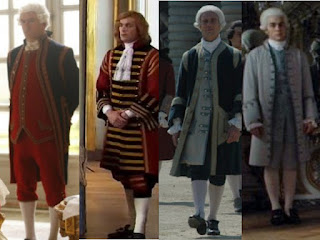Every royal and noble household had their livery - a uniform in the colours of their house worn by the servants attached to their household. This had several purposes including identifying a person as belonging to specific nobleman or royal as well as emphasizing the wealth of the master; after all, he would be the one paying for the uniform. Thus, any court in Europe was awash with servants wearing multi-coloured uniforms.
For the servant in question, the colour of his livery could mean that he was treated with respect by his peers - for instance, being clearly marked as the employee of a powerful man could have its benefits. Furthermore, it signalled to the guards and residents at court that the wearer had a reason to be at court which in itself might just spare them some unpleasant scenes.
Most movies do not feature liveries very prominently; rather, they can usually be seen briefly in the background.
The king's livery was blue, red and white - coincidentally the colours later chosen for the French flag. Other members of the royal family often chose their own; for instance, the Comte d'Artois had an apple green and Madame de Pompadour dressed hers in purple for her estate of Bellevue. Purple was also a colour of choice fro Marie Antoinette's Petit Trianon but at Versailles - where her household was largely mixed with her husband's - it was also the traditional colours.
These three uniforms featured in the 2006 movie "Marie Antoinette" by Sophia Coppola. To the left can be seen the black and gold of the Habsburgs - Marie Antoinette's family. In the middle an officer of the king's household holds open the door for the new dauphine which clearly shows the golden embroidery often adorning their uniforms. Finally, a porter can be seen bowing to the titular figure as she enters her new bedchamber. This time, the uniform is a different shade of blue and appears less ornate - this would be rather accurate, as the uniform depended on the office.
These four images show different interpretations of the king's livery. The first from the left is from the move "Louis XVI, l'Homme qui ne voulait pas être Roi" and shows by far the most modern version. The second is from "Versailles: Le Rêve d'un Roi" and shows a more 17th century version. Interestingly, the two last - both from "Jeanne Poisson: Marquise de Pompadour" are of a much lighter blue and white and has completely omitted the red and gold.
These three men clearly depicts three different households. The man to the left, wearing the otherwise Habsburg-colours, served the Marquise de Merteuil in "Dangerous Liaisons". The two other men feature in movies about English nobility: the man in green is from Jane Austen's "Love and Friendship" - the adaptation of her novel Lady Susan. Finally, the man in brown feature in "the Duchess" and as such is meant to be in the employ of the Duke of Devonshire.
This time, these liveries represent other monarchs in the 18th century. The gentleman in the dark livery with golden accents is in the fictional employ of Christian VII of Denmark-Norway ("A Royal Affair") while the man at the centre featured in the 2014 series "Ekaterina" about Catherine the Great. Finally, the sorely tried man to the right is depicted as serving George III of Great Britain in "The Madness of King George".





No comments:
Post a Comment